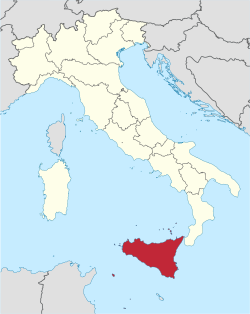
Back Sisilië Afrikaans Autonome Region Sizilien ALS ሲኪልያ Amharic Sicilia AN Sicilia ANG صقلية Arabic ܣܩܠܝܐ ARC صقلية ARY سيسيليا ARZ Sicilia AST
Sicily
| |
|---|---|
| Anthem: Madreterra | |
 | |
| Coordinates: 37°30′N 14°00′E / 37.500°N 14.000°E | |
| Country | |
| Capital | Palermo |
| Government | |
| • President | Renato Schifani (FI) |
| Area | |
| • Total | 25,832 km2 (9,974 sq mi) |
| Population (2024)[1] (8.1% of Italy) | |
| • Total | 4,785,338 |
| • Density | 190/km2 (480/sq mi) |
| Demonym(s) | English: Sicilian Italian: Siciliano (man) Italian: Siciliana (woman) |
| Citizenship | |
| • Italian | 98% |
| GDP | |
| • Total | €88.767 billion (2021) |
| Time zone | UTC+1 (CET) |
| • Summer (DST) | UTC+2 (CEST) |
| ISO 3166 code | IT-82 |
| HDI (2021) | 0.847[4] very high · 21st of 21 |
| NUTS Region | ITG |
| Website | www |
Sicily (Italian: Sicilia, Italian: [siˈtʃiːlja] ; Sicilian: Sicilia, Sicilian: [sɪˈ(t)ʃiːlja] ; officially Regione Siciliana) is an island in the central Mediterranean Sea, south of the Italian Peninsula in continental Europe and is one of the 20 regions of Italy. With 4.8 million inhabitants, including 1.3 million in and around the capital city of Palermo, it is the most populous island in the Mediterranean Sea. It is named after the Sicels, who inhabited the eastern part of the island during the Iron Age. Sicily has a rich and unique culture in arts, music, literature, cuisine, and architecture. Its most prominent landmark is Mount Etna, the tallest active volcano in Europe, and one of the most active in the world, currently 3,357 m (11,014 ft) high. The island has a typical Mediterranean climate. It is separated from Calabria by the Strait of Messina. It is one of the five Italian autonomous regions and is generally considered part of Southern Italy.
The earliest archaeological record of human activity on the island is from around 14,000 BC. By around 750 BC, Sicily had three Phoenician and a dozen Greek colonies along its coasts, becoming one of the centers of Magna Graecia. The Sicilian Wars of 580–265 BC were fought between the Carthaginians and Greeks, and the Punic Wars of 264–146 BC were fought between Rome and Carthage. The Roman province of Sicilia ended with the fall of the Roman Empire in the 5th century AD. Sicily was ruled during the Early Middle Ages by the Vandals, the Ostrogoths, the Byzantine Empire, and the Emirate of Sicily.
The Norman conquest of southern Italy led to the creation of the County of Sicily in 1071, that was succeeded by Kingdom of Sicily, a state that existed from 1130 until 1816 under various dynasties,[5][6] and in 1816 it was unified with the Kingdom of Naples into the Kingdom of the Two Sicilies. From the 1282 Sicilian Vespers until the 1860 Expedition of the Thousand, Sicily was ruled by Aragon and then Spain, either in personal union with the crown or by a cadet branch, with the exception of a period of Savoy and then Habsburg rule in 1713–1735.
The island became part of the newly unified Italy in 1860 following the Expedition of the Thousand, an invasion led by Giuseppe Garibaldi, and a plebiscite. Sicily was given special status as an autonomous administrative division on 15 May 1946, 18 days before the 1946 Italian institutional referendum.
- ^ a b "Statistiche demografiche ISTAT". Demo.istat.it. Retrieved 12 August 2024.
- ^ "Region Sicilia".
- ^ "Population on 1 January by age, sex and NUTS 2 region". www.ec.europa.eu.
- ^ "Sub-national HDI – Area Database – Global Data Lab". hdi.globaldatalab.org. Retrieved 5 March 2023.
- ^ Pasquale Hamel – L' invenzione del regno. Dalla conquista normanna alla fondazione del Regnum Siciliae (1061–1154)
- ^ "Sicilia nell'Enciclopedia Treccani". www.treccani.it (in Italian). Retrieved 22 December 2020.

